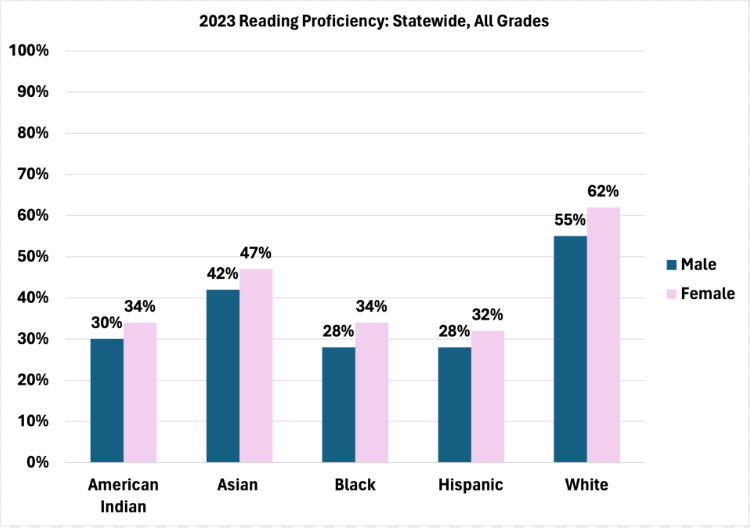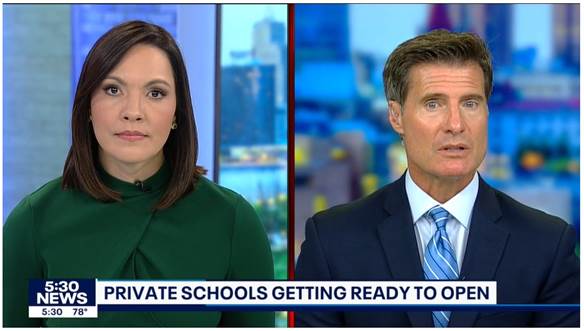In case you haven’t heard, March is Woman’s History Month, a time to celebrate women and girls and their accomplishments. It’s also a time to encourage them to break the glass ceilings of oppression they’re under.
But when it comes to the proficiency rates in Minnesota schools, I’m left scratching my head over this alleged female oppression. Why? Because data from the Minnesota Department of Education shows that the students the state’s public schools serve best are white females.
Consider the chart below. It shows Minnesota reading proficiency scores for male (blue) and female (violet) students across five racial demographics. At 62% proficiency, white girls clearly have the upper hand, while Black and Hispanic boys come in last.

“But reading is more of a female-oriented subject,” I can hear you say. “Of course girls would do better than the boys in that area!”
That’s true. Boys and girls are naturally different, and in general, girls tend to do better with reading, while boys tend to do better at math. This is not just a stereotype, either, as shown by Minnesota’s male and female math proficiency scores in the chart below:

After examining these numbers, here are a few observations:
- In general, girls tend to do about five percentage points worse than boys in math, while boys tend to do about five percentage points worse than girls in reading.
- White students lead the entire pack, with proficiency in reading and math measuring over 50% for both sexes.
- Even though white girls are behind white boys in math (about 5 percentage points), the gender gap is greater between the two sexes in reading (7 percentage points), giving girls the upper hand. Hence, when it comes to looking at which demographic is best served by Minnesota’s public schools, it seems that white girls are the winner.
But this is not often the message we hear. As mentioned earlier, it’s often implied that girls need a boost, that girls are falling behind, and that girls are the oppressed sex. In reality, it’s the boys who are increasingly struggling in school.
Christina Hoff Sommers gives us a hint on why that is in her book, The War Against Boys:
[I]ncreasingly, in our schools and in our homes, everyday boyishness is seen as aberrational, toxic—a pathology in need of a cure. Boys today bear the burden of several powerful cultural trends: a therapeutic approach to education that valorizes feelings and denigrates competition and risk, zero-tolerance policies that punish normal antics of young males, and a gender equity movement that views masculinity as predatory. Natural male exuberance is no longer tolerated.
Perhaps you’ve read this far and agree that boys are getting shortchanged in Minnesota’s public schools. Sadly, that’s not the real story here.
The real story is that ALL students in Minnesota are getting shortchanged. It’s true, white girls are leading the pack, but their 62% proficiency in reading is nothing to brag about, nor is 57% in math (white males) … or 42% in reading (Asian males) … or 20% in math (Black and Hispanic females).
Unfortunately, those scores don’t promise to improve any time soon.
Recent conversations with elected officials indicate that the Minnesota Legislature has been working overtime to implement top-down mandates for education in our state, turning themselves into a statewide school board that cancels out local education decisions.
That means that teachers—already frustrated by regulations and school administrations hindering those in the classroom from responding to discipline problems and teaching in ways they know to be effective—will find themselves forced into a corner even more, spending time fulfilling the diktats of the powers-that-be rather than actually teaching students the basics of reading and math.
If we continue on our current trajectory, refusing to provide more education options for Minnesota’s kids while also tying teachers’ hands and preventing them from pursuing effective instruction methods, then we can only expect those girls—and their male and female counterparts in the other racial demographic groups—to continue their academic nosedives in the coming years.
—
Image Credit: Pxhere













